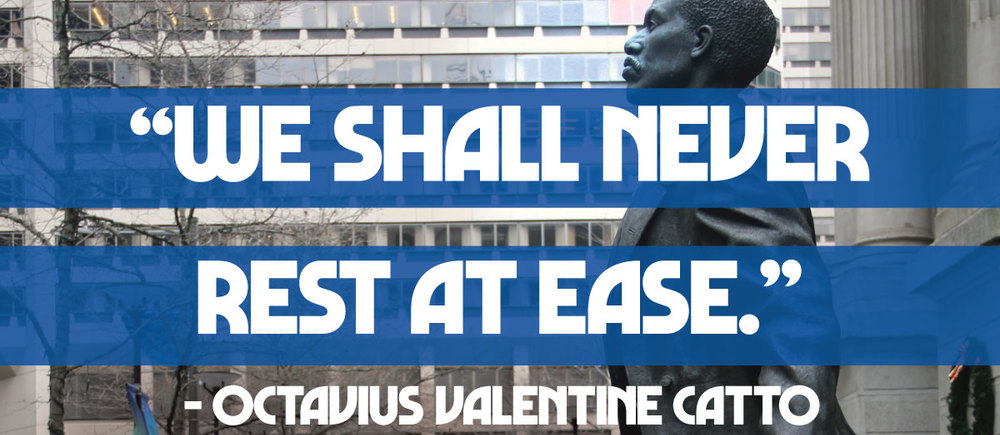
Celebrating Black History in Philadelphia
January 27, 2022

If you've been on the south side of City Hall in the past few years - you've probably seen a statue dedicated to a man named Octavius V. Catto. But you may not know much about this American hero.
Octavius V. Catto was born in 1839 and spent most of his life in Philadelphia. He was an educator, intellectual, athlete, and civil rights activist. Catto was a major in the Civil War and fought bravely for abolition and equal rights. In 1865, he fought fearlessly to desegregate Philadelphia's trolley car system by - among other actions - refusing to leave a trolley. The conductor of the trolley ran the cart off the tracks, detached the horses that were pulling it, and left Catto. He sat there all night in a courageous act of civil disobedience. The May 18, 1865, issue of the New York Times ran a story discussing the civil disobedience tactics employed by Catto as he fought for civil rights:
Philadelphia, Wednesday, May 17—2 P. M.
Last evening a colored man got into a Pine-street passenger car, and refused all entreaties to leave the car, where his presence appeared to be not desired.
The conductor of the car, fearful of being fined for ejecting him, as was done by the Judges of one of our courts in a similar case, ran the car off the track, detached the horses, and left the colored man to occupy the car all by himself.
The colored man still firmly maintains his position in the car, having spent the whole of the night there.
The conductor looks upon the part he enacted in the affair as a splendid piece of strategy.
The matter creates quite a sensation in the neighborhood where the car is standing, and crowds of sympathizers flock around the colored man.
— New York Times, May 18, 1865, p. 5
A meeting of the Union League of Philadelphia was held in Sansom Street Hall on Thursday, June 21, 1866, to protest and denounce the forcible ejection of several black women from Philadelphia's street cars. Later enlisting the help of Congressmen Thaddeus Stevens and William D. Kelley, Catto was instrumental in the passage of a Pennsylvania bill that prohibited segregation on transit systems in the state. Publicity about a conductor's being fined who refused to admit Catto's fiancée to a Philadelphia streetcar helped establish the new law in practice.
On October 10, 1871, Catto was murdered by a white man at the corner of 9th and South Streets while on his way to vote - which was just one of many instances of violence against Black people in the city that day. Catto was only 32 years old.
146 years later, in 2017, a statue was erected in his honor. This statue was made possible through the hard work of many organizations throughout the city - including SEPTA. California-based artist Branly Cadet was commissioned to create the memorial. In it, Catto strides away from five granite blocks that represent trolley cars - like the one he bravely refused to leave. In front of him is a stainless-steel and granite box that represents a 19th century ballot box. Bronze plaques and inscriptions on the pillars describe Catto’s life and inform viewers about how his accomplishments reshaped Philadelphia. It is the first public monument in Philadelphia to honor a specific African American.
February is Black History Month. It's vital that we remember and celebrate Black activists like Catto, and remember the roll that Public Transportation has played in bringing about change. People in the United States have long relied on public transportation to get to jobs and appointments, go shopping, visit family and friends, and enjoy freedom of movement. However, the struggle for the racial desegregation of transportation has a long history, as powerful whites claimed to control the freedom of movement of people of color. Below are some key individuals and organizations who took a stand against segregated transit to afford freedom of movement to all.
-
In 1841, Frederick Douglass and his friend James N. Buffum entered a train car reserved for white passengers in Lynn, Massachusetts. When the conductor ordered them to leave the car, they refused. Douglass’ and Buffum’s actions led to similar incidents on the Eastern Railroad. Widespread organizing led Congress to grant equal rights to Black citizens in public accommodations with the Civil Rights Act of 1875. However, the Supreme Court overturned this victory in 1883, declaring it unconstitutional.
-
Rosa Parks resisted segregation by refusing to move to the back of a bus. Parks’ decision to stay put was rooted in her history as a radical activist working with the NAACP and the Brotherhood of Sleeping Car Porters. She was a long time activist and in fact, days before, she had attended a mass meeting about the acquittal of the murderers of Emmett Till.
-
Dr. King went on to lead the Montgomery Bus Boycott which ended on December 20, 1956, with the U.S. Supreme Court ruling that segregation on public buses was unconstitutional.
-
Non-enforcement of the ruling was challenged by the activism and bravery of Freedom Riders who rode interstate buses into the segregated South.
-
Buses were featured in the desegregation of schools.
-
Dr. King worked alongside the founder of the Brotherhood of Sleeping Car Porters union, A. Philip Randolph, to organize the 1963 March on Washington.

Today, there remains additional work to be done to ensure equity. Ideally, equity and inclusion in public transportation includes environmentally just treatment of all neighborhoods; equity in terms of fare setting; and transit network design related to how routes are determined. There are also considerations for employment, procurement, community outreach and how we treat one another.
So this February (and all year round), take some time to think about the brave Black men and women who fought courageously for Civil Rights. People like Catto, and Parks, and Dr. King. And remember the words of Frederick Douglass: "It is not light that we need, but fire; it is not the gentle shower, but thunder. We need the storm, the whirlwind, and the earthquake."
We invite you to ride with is us to these and the many more events in Philadelphia that honor Black History:
African American Museum in Philadelphia
Come explore the first museum built by a major city to preserve, interpret, and exhibit the heritage of African Americans. The core exhibit, Audacious Freedom, highlights the contributions of African Americans in Philadelphia from 1776 - 1876. The four exhibition galleries keep history alive. To get there, hop SEPTA Route 47, 48 or 61. The Museum is also a short walk from 8th Street Station on the Market-Frankford Line and Broad Street Line (spur). Plan your trip here.
During the month of February 2022, the National Constitution Center will honor the achievements and rich heritage of African Americans and the impact theirs stories have had on constitutional history. To get there, hop SEPTA Route 17, 33, 38, 44, 47, 48, 57 or ride the Market-Frankford Line to 5th Street/Independence Hall Station. Plan your trip here.
There will be dozens of events in different libraries throughout the city celebrating Black History Month. You can see a full list here.
There will be many events at the Kimmel Center Cultural Campus. The celebration kicks off with internationally acclaimed opera singer Angel Blue and The Philadelphia Orchestra in Verizon Hall, Thursday through Saturday, February 3 – 5; the Orchestra performs the world premiere of a commission by Valerie Coleman, while Florence Price paints an orchestral picture of her life as a Black woman raised in the Post-Civil War South in her First Symphony. To get there, hop SEPTA Route 4, 12, 27, 32, or take the Broad Street Line to Walnut-Locust Station. Plan your trip here.



